Have you ever wondered how nonprofits hit the bullseye when it comes to understanding and meeting community needs?
Well, having a strategic tool to capture the heartbeat of your audience and propel your organization toward purposeful action definitely helps.
Nonprofit surveys are an unsung hero in the arsenal of community-driven impact. Today, we’ll unravel the diverse use cases that make surveys powerful catalysts for change in the nonprofit landscape.
We’ll start with how you can use nonprofit surveys and move on to the nonprofit questions, best practices, and channels of distribution.
How to Use Online Surveys for Nonprofits
Non-profit organizations operate on versatile causes, creating several opportunities for using nonprofit surveys in different ways. Here’s a list of use cases of surveys for nonprofit organizations:
Conduct Market Research
Nonprofits can leverage surveys to gain insights into their target audience, assess brand perception, and refine their marketing strategies.
You can ask nonprofit questions focused on understanding what motivates supporters, their preferred communication channels, and the effectiveness of current outreach efforts.
You could be a nonprofit organization focused on environmental conservation that wants to refine its marketing strategy to attract more supporters. By asking the right questions to the right audience, you could get really in-depth demographic insights.
Perform Event Planning
Surveys for nonprofit organizations play a pivotal role in event planning. By gathering feedback on past events and gauging interest in potential activities, organizations can ensure that their efforts align with the preferences and expectations of their community.
For example, a nonprofit specializing in youth development planning an annual fundraising event can distribute a survey with nonprofit survey questions like “What type of activities would you like to see at this year’s event?” to ensure the event aligns with community preferences.
Get Donor Feedback
One of the key ingredients to sustaining nonprofit operations is understanding donor perspectives and how they feel toward certain initiatives.
Surveys allow organizations to gather feedback on donation experiences, preferences, and motivations, helping tailor fundraising efforts to align with donor expectations.
For example, an organization focused on education wanting to enhance its donor relations can launch survey questions for nonprofit organizations like:
- “What motivated you to make a donation to our organization?”
- “How satisfied are you with the donation process?”
- “What type of projects or initiatives would you like to see funded in the future?”
Strategic Process Assessment and Planning
You can leverage non-profit surveys to collect data for strategic decision-making. Questions may revolve around long-term goals, program effectiveness, and areas of improvement, ensuring that the organization is on the right track to fulfill its mission.
Gather 360-Degree Feedback
360-degree feedback surveys are great for collecting input from various stakeholders, including staff, volunteers, and beneficiaries. This comprehensive approach provides a holistic view of the organization’s impact and areas for growth.
For example, suppose you’re running a nonprofit focused on community health and wellness. To get a comprehensive view of your effectiveness, you can implement a 360-degree feedback survey, soliciting input from staff, volunteers, and beneficiaries with questions like “How would you rate the organization’s effectiveness in promoting community health?”
If you’d like to know more about 360-degree feedback tools, check out these 10 360-degree Feedback Software
Volunteer Management
Volunteers are the backbone of any nonprofit organization, and managing them is no easy feat. For this, you can avail the benefits of surveys for streamlined volunteer management by gauging the availability, skills, and preferences of potential volunteers.
Survey data like this is invaluable for matching volunteers to suitable roles and ensuring a positive and fulfilling experience.
Track Volunteer Satisfaction
After volunteers have contributed their time, it’s essential to assess their satisfaction. Nonprofit surveys can inquire about the overall volunteer experience, areas for improvement, and suggestions for enhancing engagement.
Online Fundraising
You can leverage nonprofit surveys to optimize your online fundraising efforts. By understanding donor preferences for online giving, you can tailor your digital fundraising strategies and platforms to maximize contributions.
Here’s an example: A nonprofit relies heavily on online fundraising and wants to optimize its approach. They create a survey targeting online donors with questions like:
“What factors influence your decision to donate online?”
“How satisfied are you with the online donation process?”
49 Essential Survey Questions Nonprofits Can Ask
Let’s move on to explore relevant non-profit survey questions organizations can ask to collect diversified feedback:
Donor Relations:
- What aspects of our organization’s mission resonate most with you as a donor?
- How satisfied are you with your donation experience?
- What type of communication do you prefer for updates on our activities?
- Would you be interested in participating in exclusive donor events or webinars?
- How do you prefer to be acknowledged for your contributions (e.g., public recognition, private thank-you emails)?
- How likely are you to engage with our organization on social media platforms?
- Would you be interested in receiving more in-depth reports or insights on our organizational impact?
- Are there specific areas or projects you would like your donations to support in the future?
- Do you feel well-informed about the impact of your contributions or involvement?
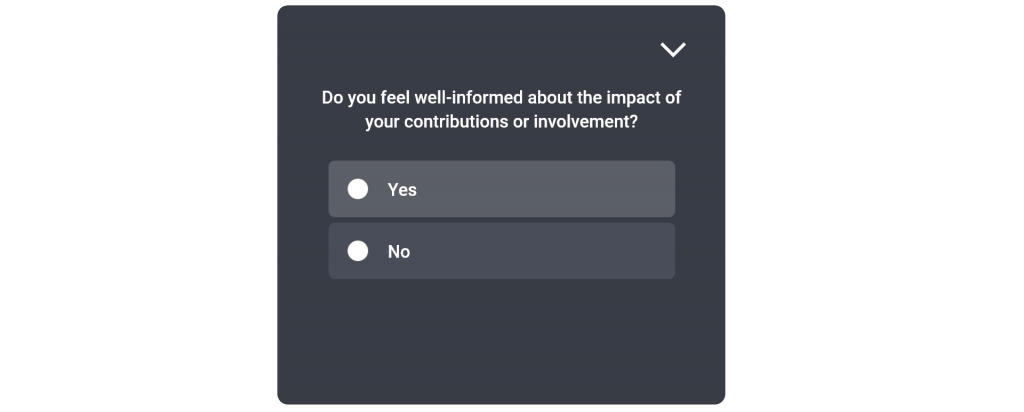
- What improvements, if any, would you suggest for our email newsletters or communication materials?
- How frequently would you prefer to receive updates on the impact of your donations?
- Do you value personalized communication from our organization, such as direct phone calls or personalized emails?
- Would you consider increasing your donation amount if you saw a clear need or opportunity for impact?
- How did you first learn about our organization, and what motivated you to make your first donation?
- Are there specific topics or areas you believe our organization should communicate more extensively about?
- In your opinion, how can our organization improve communication with its stakeholders?
Volunteer Engagement:
- What skills do you possess that you would like to contribute as a volunteer?
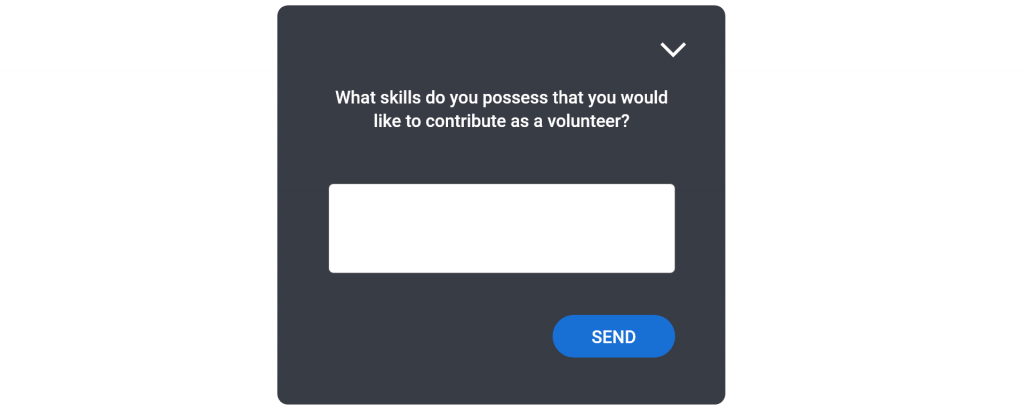
- How would you rate your overall volunteer experience with our organization?
- What type of volunteer opportunities are you most interested in?
- Would you prefer more virtual or in-person volunteer opportunities or a combination of both?
- What improvements, if any, would you suggest for our volunteer onboarding process?
- In your opinion, what distinguishes a successful and fulfilling volunteer experience?
- How likely are you to recommend volunteering with our organization to others?
- Are there additional training or resources you believe would enhance your volunteer experience?
- What time of the week or month works best for your availability to volunteer?
- Do you feel adequately recognized and appreciated for your volunteer contributions?
Event Feedback:
- On a scale of 0 to 10, how would you rate the overall experience of the event?
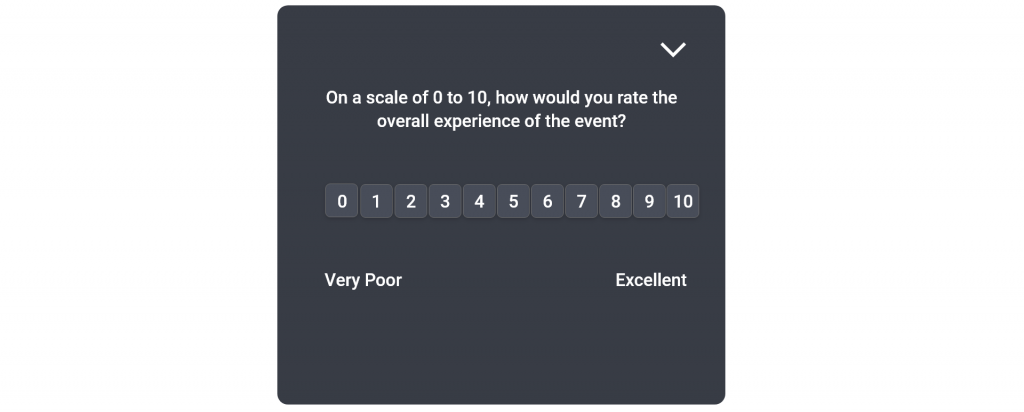
- What aspects of the event did you find most engaging?
- What improvements would you suggest for future events?
- Was the event schedule convenient for your participation? If not, please provide suggestions.
- How likely are you to attend future events hosted by our organization?
- What motivated you to attend this event, and did it meet your expectations?
- Did you find the event content relevant and engaging?
- Were the registration and check-in processes smooth and efficient?
- What types of events would you like to see organized in the future?
Check out more event feedback survey questions.
Strategic Planning:
- What long-term goals do you think our organization should prioritize?
- How effective do you find our current programs in fulfilling our mission?
- What challenges do you see that we should address in the coming years?
Community Engagement:
- How connected do you feel to our organization and its activities?
- In what ways can we better involve the community in our decision-making processes?
- What community events or initiatives have resonated with you the most?
- How likely are you to participate in community-led projects or initiatives facilitated by our organization?
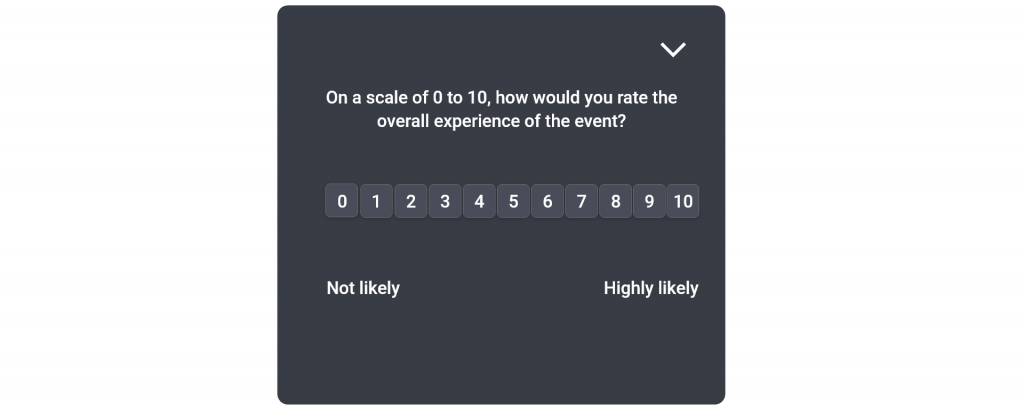
- Would you be interested in participating in focus groups or community forums to discuss local issues?
Diversity and Inclusion:
- How would you rate our organization’s commitment to diversity and inclusion?
- Do you feel our programs and initiatives adequately address the needs of diverse communities?
- What steps could we take to enhance diversity and inclusion in our organization?
Technology and Accessibility:
- How user-friendly are our online platforms, including the website and donation process?
- Would you prefer more or less engagement through digital channels such as social media and email?
- Are there any accessibility features or improvements you would recommend for our digital platforms?
Nonprofit Survey Best Practices: The ‘HOW’ Behind Participant Engagement
The only way you’ll get your efforts worth is if the audience takes the surveys and completes them. Half abandoned surveys only tell half of the story, rendering the data unreliable.
So, here are a few non-profit survey best practices for you to follow to enjoy a high response rate:
Clearly Define Objectives
Before launching a survey, it’s crucial to have a clear understanding of what you want to achieve.
Define the specific goals and objectives of the survey to ensure that the nonprofit questions align with the information you need.
Whether it’s improving volunteer satisfaction or refining your marketing strategy, a well-defined purpose sets the foundation for a successful survey.
No One Likes Long Surveys; Keep Them Short
Respect your respondents’ time and attention. Long, convoluted surveys can lead to fatigue and a decline in response rates.
Keeping surveys concise ensures that respondents can efficiently provide valuable feedback without feeling overwhelmed. You should focus on essential questions that directly contribute to your survey objectives, making the most of both your respondents’ time and your data collection efforts.
Branching and Skip Logic for Relevant Feedback
You need to ask relevant nonprofit questions for your surveys to be effective. Branching and skip logic are the essential tools you can use to ensure you are collecting the right information from the right people.
Branching logic will help you map out a survey roadmap where you can ask contextual follow-up questions to dig deep and collect core insights.

With skip logic, you offer an opt-out option to respondents to not answer sensitive questions or the ones that they find irrelevant.
Anonymity Encourages Honest Feedback
Honest input, even if critical, is invaluable for nonprofits seeking genuine insights. People are more likely to provide honest and constructive feedback when they feel their responses are confidential.
So, always assure respondents that their feedback will remain anonymous, fostering a sense of security. Qualaroo is one such survey tool that collects anonymous feedback by default. So you won’t have to jump through hoops to collect feedback anonymously.
Give this a read: 10 Best Anonymous Feedback Tools to Collect Unbiased Insights
Diversify Question Types
To gain a comprehensive understanding of your community’s perspectives, use a variety of question types.
You can combine multiple-choice questions for quantitative data, open-ended questions for qualitative insights, and rating and Likert scale questions for nuanced responses.
Here’s a related read: Qualitative vs. Quantitative Research: How to Get the Best of Both Worlds
Diversifying question types provides depth to your survey, capturing both the breadth and depth of opinions and experiences. This approach ensures a well-rounded view for effective decision-making.
Sentiment Analysis for Nuanced Insights
Sentiment analysis is a transformative tool for nonprofits, extracting nuanced insights from survey feedback data. By deciphering the emotional tone of responses, nonprofits can swiftly identify positive trends, prioritize actionable insights, and tailor their strategies for optimal impact.
Whether gauging public sentiment on advocacy campaigns, tracking the success of fundraising efforts, or refining education programs based on teacher and student feedback, sentiment analysis guides nonprofits toward informed decision-making.
An online survey tool like Qualaroo offers this feature and helps you visualize respondents’ emotions using word clouds. It highlights the most-used words in the responses and the emotions they represent.
Why Consider Nonprofit Surveys for Collecting Insights?
If you’re still contemplating why you should leverage online website surveys for your non-profit organization, here are a bunch of benefits that’ll help you make up your mind:
Align Services With Stakeholder Needs
Nonprofit surveys act as a vital tool to bridge the gap between organizational goals and the expectations of stakeholders.
By directly engaging with donors, volunteers, and beneficiaries, nonprofits can gain insights into their evolving needs and preferences.
For example, a youth empowerment nonprofit might use surveys to understand the educational aspirations of the youth they serve, ensuring that their programs align with the aspirations and expectations of their stakeholders.
This alignment not only enhances service relevance but also strengthens the connection between the nonprofit and its community.
Measure the Impact of Your Effort
Directly measuring the impact of programs and initiatives is critical for nonprofits to demonstrate accountability and transparency. Nonprofit surveys allow organizations to collect feedback from those directly impacted by their work.
For instance, a health-focused nonprofit conducting a survey among its beneficiaries can assess the perceived impact of health education programs on lifestyle choices.
This first-hand feedback provides valuable qualitative and quantitative data, enabling the nonprofit to gauge the effectiveness of its interventions and make data-driven improvements.
Promote Continuous Improvement
Surveys play a pivotal role in fostering a culture of continuous growth and development within nonprofits. By regularly seeking feedback, organizations can identify areas for improvement and innovation.
For instance, a community outreach nonprofit conducting post-event surveys may discover suggestions for enhancing the accessibility of their programs. This commitment to continuous improvement ensures that nonprofits stay responsive to changing community needs.
FREE. All Features. FOREVER!
Try our Forever FREE account with all premium features!
Nonprofit Surveys: Channels of Distribution
More often than not, the audience is spread across different channels of communication. And so, you have to meet them where they are. Qualaroo’s in-context surveys achieve a 10-30% response rate due to their immediate and seamless placement in the user experience.
Website
Integrating popup and intercept surveys or survey widgets like Sidebar forms on your nonprofit’s website provides an accessible avenue for stakeholders to share their thoughts.
Popup surveys are non-intrusive and appear on your website when the visitors meet certain requirements you set to trigger the surveys.
Sidebar forms, on the other hand, are widgets that become a part of your website, so respondents can take the survey anytime, as per their accord.
In-App
For nonprofits with mobile apps, in-app surveys offer a convenient and targeted way to gather feedback from users.
For instance, a disaster relief organization might use an in-app survey to collect real-time insights from volunteers on the ground, ensuring quick adjustments to response strategies based on their immediate experiences.
This method leverages technology to streamline data collection and enhances the user experience by integrating feedback opportunities seamlessly within the app.
You can create effective in-app surveys with Qualaroo and collect diverse feedback from your community.
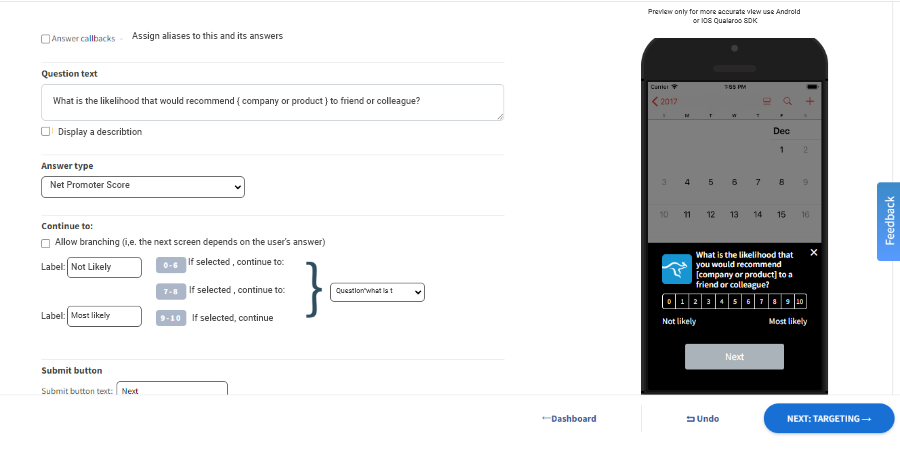
Check out : 7 Effective Tips to Increase Survey Response Rates
Survey Links for Email and Social Media
Leveraging emails, newsletters, and social media platforms to share survey links expands the reach of your data collection efforts.
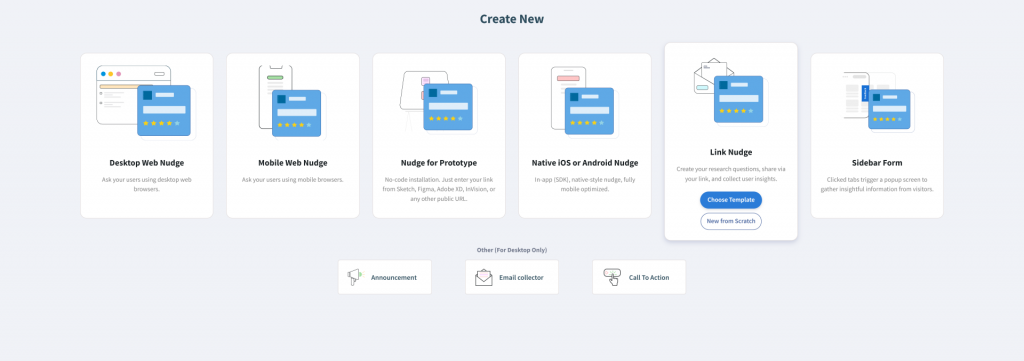
For instance, a human rights advocacy nonprofit may share a survey link on social media to gather opinions on current social justice issues.
This way, they’ll broaden the survey’s audience, reaching individuals who may not regularly visit the organization’s website but are active on social media or subscribed to newsletters.
QR Code Scan Surveys
Utilizing QR codes for surveys enhances accessibility, particularly in physical spaces or printed materials.
These are great for collecting feedback during a physical event, as you can place the QR code throughout the location. You can use ProProfs Survey Maker to create nonprofit surveys with a QR code scan.
Take Your Cause to the Next Level With an Effective Action Plan
By now, you know that nonprofit surveys can open windows into the minds of donors, your community, and volunteers.
The insights from all these directions can help you organize and strategize better so you can build upon your effort and create smart goals that add to your cause.
But remember this: For the feedback insights to be a catalyst for your cause, you need to ask the right nonprofit questions to the right people, something which Qualaroo is an expert at. So, start creating surveys and get valuable and action-driven insights for your organization
 Tips
Tips
We’d love to hear your tips & suggestions on this article!
FREE. All Features. FOREVER!
Try our Forever FREE account with all premium features!

 We'd love your feedback!
We'd love your feedback! Thanks for your feedback!
Thanks for your feedback!

